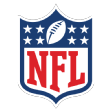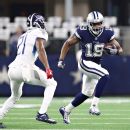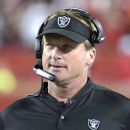ARLINGTON, Texas — On the second play from scrimmage, Amari Cooper caught his first pass with the Dallas Cowboys for an 11-yard gain, leading the fans to yell, “Coooooop.” By the end of the third quarter, the “Coooop” had turned to boos.
The Cowboys are only at the midway point of the season, but Monday’s 28-14 loss to the Tennessee Titans seemed crushing.
The Cowboys felt energized by the trade with the Oakland Raiders for Cooper as well as the change from Paul Alexander to Marc Colombo at offensive line coach. Coming off the bye week, they felt like they had a solid week of preparation with quarterback Dak Prescott calling it “chippy,” but in a good way.
To come up empty at AT&T Stadium, where they had been perfect thus far this season, can be viewed only as deflating. With eight games left, the Cowboys (3-5) still have a mathematical chance to win the NFC East or earn a wild-card bid, but all of their faults were on display against the Titans.
“When you’ve played eight games and only won three, that’s a cause for concern,” said owner and general manager Jerry Jones, who added there is no scenario in which he would make an in-season head-coaching change with Jason Garrett.
On the Cowboys’ third possession, Prescott forced a pass to a double-covered Cooper in the end zone from the Tennessee 6-yard line on second down. Instead of another chance on third down or a chip-shot field goal, Prescott went to his new weapon haphazardly and was intercepted.
The Titans answered with a 15-play, 80-yard drive to tie the score.
“That was the difference, simple as that,” Prescott said. “Our defense gets us a turnover there. We’re up seven points. We go down there and I try to force the ball and give it right back to them. That’s a 14-point swing. They go back down the other end and get a touchdown and tie it up. It’s 14-0 if we convert on that. So I mean that’s the difference right there, 14 points.”
On the Cowboys’ first possession of the second half, Prescott was sacked by Jayon Brown and fumbled. Wesley Woodyard recovered, and like the Titans did after Prescott’s first turnover, they turned it into a touchdown for a 21-14 lead.
 Everything you need this week:
Everything you need this week:
• Scores, highlights and more »
• Full schedule » | Full standings »
• Weekly stats leaders »
• Updated playoff picture »
• Injuries tracker: Who’s in, out »
More NFL coverage »
It was the fourth lost fumble Prescott has had in eight games. He had three lost fumbles last season and four as a rookie.
A Cowboys defense that started fast wilted. Dallas allowed touchdown drives of 80 and 69 yards in the first half and saw Marcus Mariota do to them what the Cowboys want Prescott to do. The Titans converted 11 of 14 third-down tries. Mariota was methodical in the passing game (21 of 29, 240 yards, two touchdowns) and ended the Cowboys’ chances with a 9-yard touchdown run with 4 minutes, 38 seconds to play.
There is only a one-game difference between 3-5 and 4-4, but mentally those records are miles apart.
With road games coming up against the Philadelphia Eagles, who are coming off their bye week, and the Atlanta Falcons, who have won three in a row, the Cowboys find themselves with their season the line. Oh, the Cowboys are winless away from home, matching the loss total (four) they had away from home in Prescott’s first two seasons as the starter.
For Prescott and Garrett, more than the season might be on the line. Their futures — short- and long-term — are on the line.
“It’s disappointing,” Prescott said. “We didn’t get the job done. It starts with me. Starting with me first and all the way throughout this whole team. Very disappointing coming off the bye week — cleaned things up, felt good going into this one. To come out with this loss, being 3-5 is very disappointing.”








